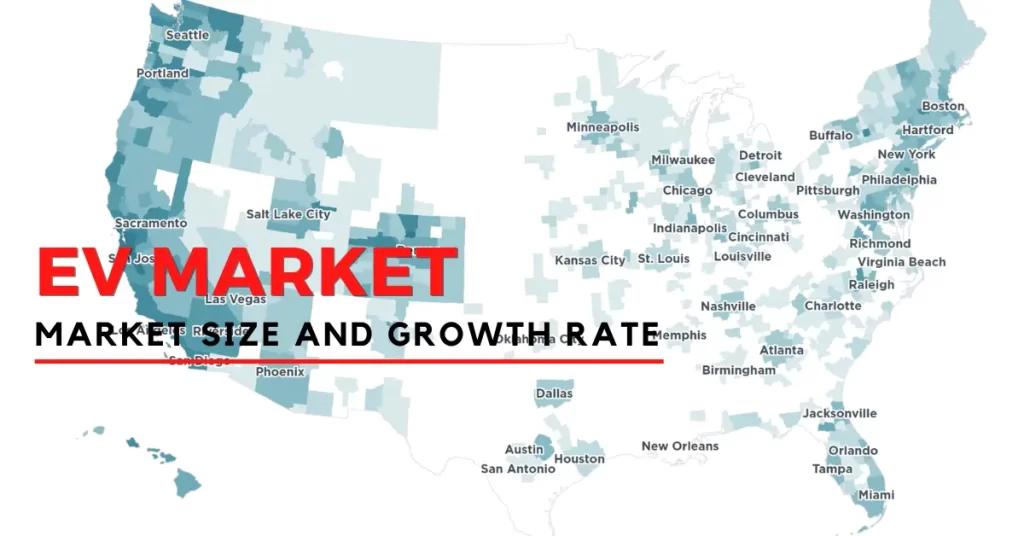The EV dealership in the US market is expected to grow from USD 28.24 billion in 2021 to USD 137.43 billion in 2028, with a CAGR of 25.4% from 2022 to 2029.
Without a doubt, more and more people are buying electric cars. Even though there was a pandemic during the second half of 2020, more electric vehicles (EVs) were registered worldwide. In the same year, the value of the world’s electric vehicle market went up by $163.01 billion.
As more countries sign the Paris Agreement on climate change, carbon-free solutions like electric cars are becoming more popular. This, in turn, is giving early adopters new business chances.
Let’s look at how global sales of electric vehicles (EVs) have changed from one year to the next.
Nearly 6.5 million electric passenger cars, such as battery-electric (BEV) and plug-in hybrid (PHEV), will be sold worldwide in 2021. Because of COVID-19 and other rules, EV sales worldwide were below their long-term trend in 2019 and 2020. In 2021, sales increased by 109% compared to the previous year.
The EV market made up 10% of the world’s auto market at the start of 2022. While talking about the global EV market, let’s look at where EVs are sold worldwide.
As EV sales rise, there will be a significant change in how dealers make money.
Car dealers will likely sell more EVs in the coming years, significantly affecting their profits from front-end and back-end businesses.
Impact on front-end sales
Due to the high cost of battery packs, power electronics, and e-motors, and the lack of economies of scale to lower production costs, new EVs are more expensive than ICE vehicles. As battery prices keep decreasing, it will take until 2024 or 2026 to reach cost parity.
Change how you think about service. Service and reconditioning centers will need to set up new point-of-sale processes, train technicians and other service staff on how to handle high-voltage systems safely, and buy the special tools and equipment they need to work on electric powertrains to keep up with the growing number of EVs. Since EVs have new tools, capabilities, and a learning curve, car dealerships will need to put more money into being ready for after-sales service.
Some OEMs have changed their dealer contracts to reflect the shift toward selling electric vehicles. They have done this by setting specific goals, asking for transparent charging infrastructure, and requiring extra steps in battery maintenance and handling.
Rethink how you run your dealership. Dealers could add non-brand EVs to their used car inventory to get more customers and become trusted EV stores for many brands and models. Also, dealers might want to change the contract model between OEMs and dealerships, such as by letting dealers fulfill online orders.
Effect on parts and services in the back end
Train the people on the front lines and change the sales process. Dealers can continue to digitize the sales process and offer a seamless, omnichannel experience that includes more than just the EV itself, like charging and service. They can improve the customer experience by installing EV-specific showroom features, like fast-charging stations. They can also give customers a complete package that makes owning an EV as easy as possible (for instance, selling preferred installation services for at-home charging equipment).
Insurance and money. The picture needs to be clarified regarding financing and insurance (F&I). Most EVs cost between $5,000 and $10,000 more than similar ICE vehicles. Even though the front-end gross margins on new EV sales look pretty bad, the back-end looks better for car dealerships. Finance reserves, or the part of the buyer’s interest rate the dealership gets for securing the car loan, are a source of income for many dealerships.
Because of this, more buyers will probably need help from the dealer’s finance department. This should lead to more financing deals and leases for electric vehicles. Also, lease deals will rise until people have more faith in batteries. Smart dealers with local installation services could also offer customers financing contracts for car batteries and equipment charging their cars at home.
End Thoughts on EV Dealership in the US
As a result of the severe limitations in available stock, numerous dealer networks are reporting all-time high earnings. However, online and digitally enabled sales models are being led by new digital disruptors rapidly expanding their market share.
There may be a continued inventory shortage until 2022. Still, the EV revolution is gaining momentum thanks to government action toward a greener economy, rising consumer demand, and an expanding number of original equipment manufacturers (OEMs) diversifying their product lines to include EVs.
As OEMs develop more direct-to-customer, go-to-market models and EV price and maintenance vary, traditional dealer profit pools will be under even greater pressure in the future. It results in slimmer sales margins and reduced aftersales parts revenue. Dealerships will need creative approaches to take advantage of the changes in their profit margins.




 and Canada
and Canada 





Comments are closed.